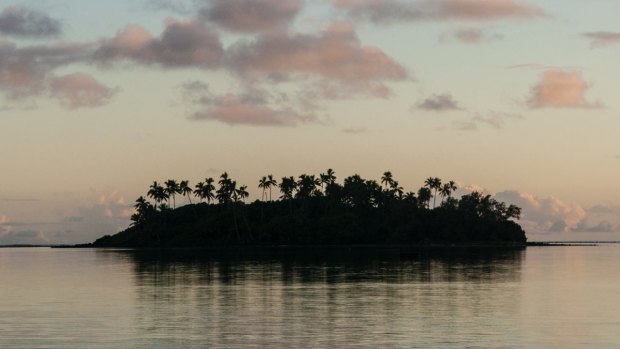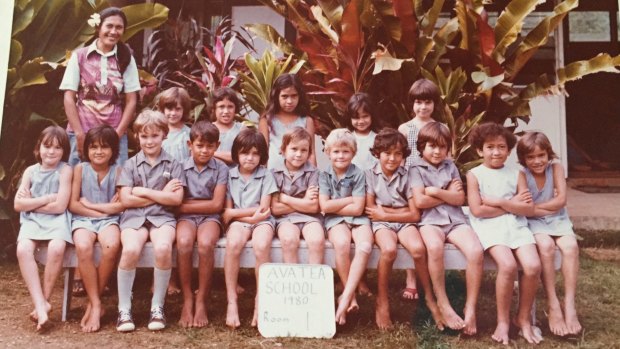This was published 5 years ago
Why I have spent a lifetime revisiting the Cook Islands
By Craig Tansley

Tropical island at sunset, Rarotonga Island, Cook Islands. Credit: Stocksy
You could say I was a lucky kid: I was born and raised on Rarotonga (Raro). Then, when my parents split, I spent the rest of my childhood in Byron Bay. The funny thing is, I can hardly remember those Byron years – I drive through town now and I barely recognise the place (there were no Porsche four-wheeldrives back then, for a start), even though I live very near it.
And yet, when I return to Rarotonga, it's like I never left at all. It still looks exactly the same and smells like it always did, all sweet tiare maori (Rarotonga's native gardenia) and frangipani wafting on a warm breeze, and backyard burn-offs (Cook Islanders have a penchant for tidiness; a blade of grass out of place is cause for neighbourhood scandal). I smell it all the moment I arrive, as I walk down the stairs to the tarmac. It's like I'm still seven … Innocence, it would seem, isn't always lost.
There are still no traffic lights here, thank god. I'm more likely to run into a pig than a traffic jam. The speed limit is 50km/h on the open road, though no one travels that fast.

The author (front row centre, above the sign) with classmates at Raro.Credit: Courtesy of Craig Tansley
There's no high rise, either – no building can be taller than a coconut tree. That's the law. The local paper still writes about taro (a root vegetable that's the staple of the Polynesian diet) theft as if it's terrorism; out there on Ara Metua, the Pacific's oldest road, a lot of locals still grow it to survive. Us kids never dared to go beyond that thousand-year-old road – no one lives in the big green mountains, where people told us there were sacrificial altars full of human skulls.
Even today, locals can't get far beyond their taro plantations. The forest's too thick, the mountains are too steep (there are maraes – ceremonial grounds – deep in this hinterland which few have ever visited). But these days I like to ride a moped along the dirt trails which lead high up into the island's 22 water catchment areas beneath the rim of Raro's caldera, and rejoice in the fact that I'm not scared any more.
Though truth be told, there wasn't much to be afraid of on Raro … besides these ghosts of cannibals past. There certainly wasn't any stranger danger; who's a stranger on an island you can drive round in 40 minutes? I'd spend entire weekends with my friends and brothers – Mum wouldn't see me until Sunday dinner. We'd swim to the uninhabited motus (small islands) in Muri Lagoon and camp overnight. I could swim – I learnt by dog-paddling between coral heads in the lagoon just outside my house – so what else did my parents have to worry about?
Anyway, locals always kept an eye out for us sunburnt little papaiis (white people), who they fussed over even if we never did go with them to church. Everything shut down on Sunday then, and even today you won't find a bar open past midnight on Saturday. Locals never Bible-bashed, but don't expect to start a meal in any of their homes without a whole lot of head bowing and thanking just about everyone on the island for the food you're about to receive.
There are quirks about Raro I've never noticed anywhere else. Who else buries their beloved in the front yard, so they can have a coffee with them each morning … and a beer in the evening? (And what happens if they want to move house?) Do all old expats drink with their backs to the view like they do at Raro's best watering hole, Trader Jacks? And where else on earth do people smell so deliciously edible every time they go out (locals use coconut oil on their hair and skin).
And boy, do Cook Islanders like to go out – dining is the national pastime of the Cooks, and if there was a Commonwealth Games event for it, they'd finally win a gold medal. There are restaurants now on every block, and sunset bars. When I was a kid, we mostly ate at island feasts in people's backyards on Sundays – pork, fish, chicken, taro and other vegies cooked in the hot coals of a freshly dug underground oven called an umu, all covered in banana leaves.
I go back most years. Dad's still there – he won't ever leave (he's one of those old blokes with his back to the sea at Trader Jacks). While I can't help noticing more tourists now, there's never much of a crowd. You see them on the plane in, then wonder where they disappeared to when you see them again at Departures.
Most tend to gather round the shops and cafes near Muri Lagoon – tourists have a habit of herding. I bet most of them don't realise they can have huge swathes of the island to themselves just a few hundred metres off the Ara Metua. But 360,000 Aussies will visit Fiji this year, about 90,000 will go to Vanuatu, yet barely 24,000 will travel that little bit further to Rarotonga.
Suits me, though. I think it's because of this relative obscurity that Raro's stayed the same. Byron Bay's become home to Hollywood heartthrobs and billionaires, but locals here still wear button-up shirts with flower prints and dance to the Bee Gees, and call you auntie, or uncle, and giggle like little girls should you attempt a joke. Same as they ever did.
MORE TASTES OF PARADISE
The Cook Islands aren't the South Pacific's only tropical jewels. Here are three more just a few hours away by plane.
NEW CALEDONIA
It's the closest of all our South Pacific neighbours, barely 2½ hours away by plane, yet New Caledonia is almost entirely overlooked in our mass exodus to Fiji, 90 minutes further away. Sure, as a French territory you can expect the sort of prices you might find in Tahiti or Bora Bora; but imagine: a tiny tropical version of France right under our noses.
Its capital, Nouméa, sits on a peninsula surrounded by bays. French gastronomic treats are served up in restaurants under coconut trees. There are no more sophisticated food offerings in the whole South Pacific than in Nouméa's Quartier Latin.
And then, of course, there are the lagoons. New Caledonia is home to the world's longest continuous barrier reef (second in overall size to the Great Barrier Reef), creating a massive World Heritage-listed site. Divers, sailors, fishermen, snorkellers and kayakers should rejoice. And if you want more seclusion, few tourists apart from cruise passengers make it out to New Caledonia's Loyalty Islands, where there are caves and lagoons to explore, and island feasts with local families to be enjoyed.
VANUATU
Vanuatu is as wild as you want it to be. While its capital, Port Vila, is modern and full of cafes, restaurants and bars, just beyond is one of the Pacific's most untapped destinations. That's not to say there's no sophistication; Vanuatu is home to excellent resorts. But on most of the 83 islands that make up the archipelago, life goes on as it has for hundreds of years.
Fly 45 minutes south to Tanna for a close-up view of a volcano; at twilight, hike to the rim of the caldera and look inside as it erupts. Villagers still live in the forests here, and one of the Pacific's most innovative eco-destinations, Rockwater Resort, has just opened.
Fly 50 minutes north to Espiritu Santo, where you'll find luxurious private island resorts while also discovering that locals still bring bows and arrows to its main town, Luganville. Divers can explore the SS President Coolidge, a globally famous wreck dive site just off the coast. For more adventure, watch locals jump to earth with vines tied to their ankles on Pentecost Island.
FIJI
Many visitors think of Fiji as one island, but there are 333 of them. The main island, Viti Levu, hosts most of Fiji's international visitors but the rewards are there for those who explore further.
Often you don't have to go very far: Denarau Island, with its international hotel chains and the country's most established resorts, is attached to Viti Levu by a short causeway. A quick boat ride from Denarau Island's marina will take you to the 20 tiny islands of the Mamanucas, with twoto five-star resorts and some seriously gnarly surfing waves. From there, consider taking a boat another houror-so north to the Yasawas. Closed to land-based tourism until just 30 years ago, locals still live in traditional villages alongside everything from $2000-a-night private island resorts to flashpacker hostels on the beach.
Those wanting to go further can find their own Fiji away from visitors via a short plane ride. Adventurous travellers should fly an hour north to Fiji's second largest island, Vanua Levu. Here, the diving is world class and visitors can hike the island's many national parks. At Taveuni, 90 minutes by air from Nadi, the Garden Isle offers stunning waterfalls and romantic hotels and resorts.
This article appears in Sunday Life magazine within the Sun-Herald and the Sunday Age on sale February 24.
Sign up for the Traveller Deals newsletter
Get exclusive travel deals delivered straight to your inbox. Sign up now.